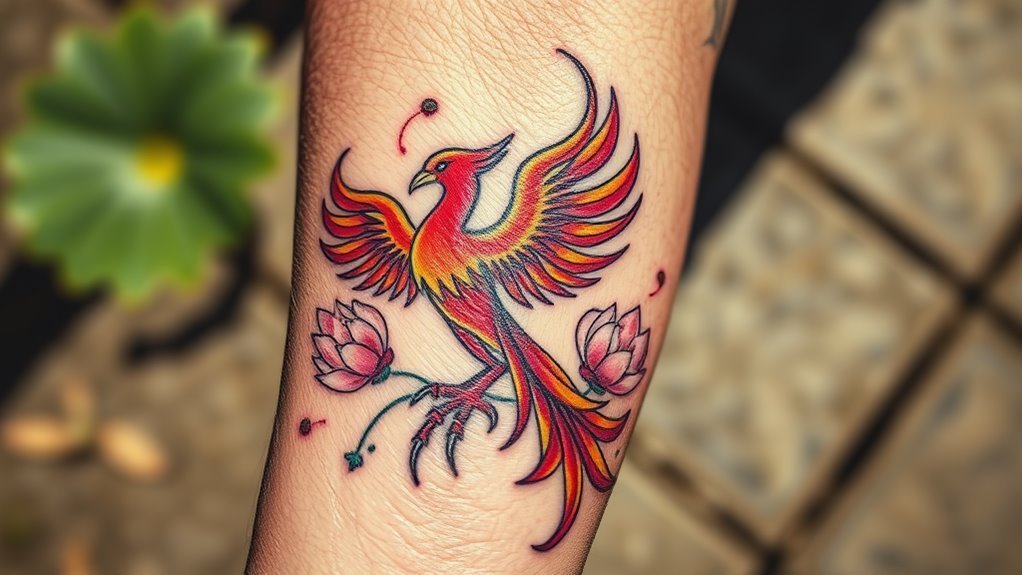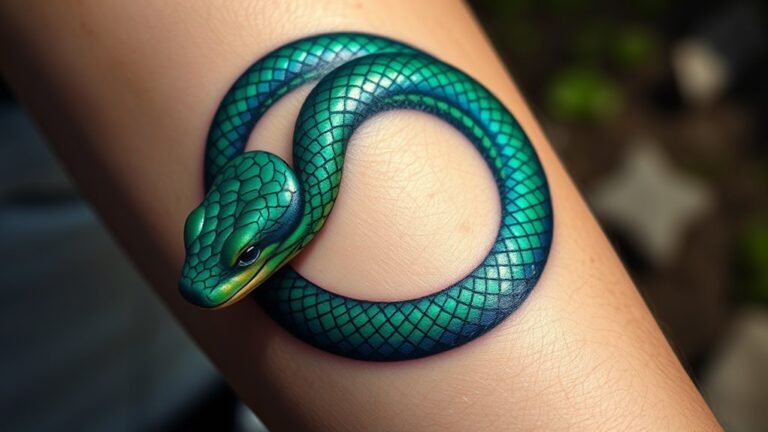Tattoo Meaning and Symbolism
When you think about tattoos, you might see them as mere body art, but they often represent much more. Each inked design can tell a story, reflecting personal milestones or cultural heritage that connects you to a larger narrative. Those intricate symbols you see aren't just random; they carry meanings that can resonate deeply with the wearer. As you explore these layers, you might find that the significance of tattoos extends beyond the skin, inviting a closer look at the stories behind them and the identities they represent. What might your own tattoo say about you?
Historical Significance of Tattoos
Throughout history, tattoos have served as powerful symbols of identity, culture, and belief. You might find it fascinating how ancient practices of tattooing reveal more than mere body art; they reflect the values and norms of societies that created them. In numerous cultures, tattoos signified rites of passage, marking the change from childhood to adulthood or denoting social status.
For instance, the indigenous Maori of New Zealand used intricate tattoos, known as ta moko, to convey lineage and tribal affiliation, embedding personal stories into their skin.
However, societal perceptions surrounding tattoos have evolved markedly over time. In some eras, tattoos were embraced as symbols of bravery or spiritual depth, while in others, they were stigmatized as markers of criminality or rebellion.
As you explore the historical significance of tattoos, it becomes clear that they've acted as a canvas for expressing belonging, often reflecting the complexities of cultural identity. By understanding these ancient practices and shifting societal perceptions, you can appreciate how tattoos connect individuals to their heritage and foster a sense of community in an increasingly fragmented world.
Common Tattoo Symbols and Their Meanings
When exploring common tattoo symbols and their meanings, you'll discover a rich tapestry of imagery that resonates across various cultures and personal experiences.
These symbols often serve as a bridge, connecting you to deeper meanings and shared histories. Understanding these symbols can foster a sense of belonging within a community that values personal expression.
Here are three prevalent tattoo symbols and their meanings:
- Flowers: Flower symbolism varies widely. For example, roses often represent love and passion, while cherry blossoms symbolize the transient nature of life. Choosing a flower tattoo can reflect your personal journey or values.
- Animals: Animal meanings carry significant weight. A wolf might symbolize loyalty and family, while an elephant can represent strength and wisdom. By selecting an animal tattoo, you embrace qualities that resonate with your identity.
- Infinity: The infinity symbol conveys eternal love and endless possibilities. It's a popular choice for those who wish to signify lasting connections or aspirations.
Cultural Variations in Tattoo Art
Tattoo art serves as a profound reflection of cultural identity, embodying the traditions, beliefs, and histories of diverse communities. When you explore the world of tattoos, you'll notice how tribal influences shape the artistry in various regions.
For instance, Polynesian tattoos, rich with intricate patterns, tell stories of ancestry and social status, deeply rooted in the culture's history. Similarly, Native American tattoos often feature symbols that connect individuals to their spiritual beliefs and communal ties.
As you dive deeper into regional styles, you'll see how geographical factors and historical contexts inform the techniques and designs used. Japanese tattoos, with their bold colors and elaborate imagery, often depict mythological creatures, serving as a canvas for storytelling and personal narrative.
In contrast, Western tattoos might lean toward minimalist designs, reflecting contemporary aesthetics and personal expression.
Personal Stories Behind Tattoos
Every tattoo carries a story, often deeply personal and reflective of the individual's journey.
These stories can serve as powerful tattoo inspiration, showcasing moments of triumph, loss, or transformation. When you look at someone's ink, you're often peering into their soul, revealing layers of meaning behind seemingly simple designs.
Consider these three common sources of inspiration for meaningful designs:
- Life Events: Many choose tattoos to commemorate significant milestones, like the birth of a child or overcoming a challenge, creating a visual reminder of resilience.
- Cultural Heritage: Tattoos can express pride in one's background, connecting you to your roots and community, fostering a sense of belonging.
- Personal Beliefs: Symbols that represent personal philosophies or ideologies can be a profound way to articulate your identity, making a statement about who you are.
These narratives make your tattoo more than just body art; they encapsulate experiences that define you.
Popular Tattoo Designs and Symbolism
Among the countless tattoo designs that people choose, a few stand out due to their rich symbolism and cultural significance. Tribal designs, often rooted in ancient traditions, represent a deep connection to one's heritage or a community. These intricate patterns convey stories of ancestry, strength, and identity, allowing you to express a sense of belonging to a larger narrative.
When you opt for these designs, you're not just getting inked; you're embracing a piece of history that can resonate with your personal journey.
Animal motifs are another popular choice, offering a variety of meanings based on the specific creature. For instance, a lion symbolizes courage and leadership, while a butterfly often represents transformation and new beginnings.
By choosing an animal to adorn your skin, you align yourself with its qualities and traits, forging a connection that can serve as a source of inspiration or motivation.
Both tribal designs and animal motifs invite reflection on your values and aspirations. In a world that sometimes feels fragmented, these tattoos can be a powerful reminder of your roots and your path, helping you find a sense of unity and purpose in your life.
The Role of Tattoos in Identity
Identity often finds expression in the form of tattoos, serving as a canvas for personal narratives and cultural affiliations. When you choose to get a tattoo, you're not just marking your skin; you're asserting who you're and where you belong.
Tattoos can act as powerful symbols of identity expression, reflecting your journey, beliefs, and connections to communities.
Consider how tattoos can empower you in three significant ways:
- Cultural Heritage: Tattoos can celebrate your roots, showcasing symbols that honor your ancestry and cultural background.
- Personal Milestones: Each tattoo can represent pivotal moments in your life, serving as a reminder of your growth, struggles, and triumphs.
- Social Belonging: Tattoos can forge bonds with others who share similar values or experiences, creating a sense of unity and belonging.
Through tattoo empowerment, you embrace your individuality while simultaneously connecting with a larger narrative.
This intersection of personal and collective identity transforms your body into a living representation of who you are, fostering a deeper sense of belonging in a world that often seeks to categorize and define us.
Trends in Modern Tattoo Art
As you explore the world of tattoos, you'll notice a fascinating evolution in modern tattoo art that reflects broader cultural shifts and individual expressions. Minimalist tattoos have surged in popularity, appealing to those who value simplicity and subtlety.
These designs often convey deep meanings through clean lines and sparse elements, creating a sense of belonging among fans of understated artistry.
Watercolor tattoos are another trend capturing attention, as their vibrant hues and fluid forms mimic the beauty of paint on canvas. This style allows for personal interpretation, fostering a connection between the wearer and the artwork.
Geometric designs have also made their mark, combining precision and abstraction, appealing to those who appreciate symmetry and structure.
Nature-inspired tattoos resonate with many, celebrating the environment and our connection to it, while abstract art allows for a more personal and emotional expression.
Cultural fusion in tattoo art brings together diverse styles and traditions, creating a rich tapestry of meaning that reflects the globalized world we live in.
Each of these trends speaks to a collective yearning for identity, connection, and the stories we choose to tell through our skin.
Frequently Asked Questions
How Do I Choose the Right Tattoo Design for Myself?
To choose the right tattoo design, reflect on personal significance and how it resonates with your identity. Explore various design styles, considering what connects you emotionally, ensuring it represents your journey and belonging in the world.
What Should I Consider Before Getting My First Tattoo?
Before getting your first tattoo, consider your tattoo motivation and pain tolerance. Reflect on why you want this mark, and make certain you're prepared for the physical experience, embracing both the beauty and the potential discomfort.
How Can I Take Care of My Tattoo During Healing?
To care for your tattoo during healing, establish a consistent aftercare routine. Keep it clean and moisturized, avoiding sun exposure. Typically, healing lasts two to four weeks, so patience and diligence are essential for best results.
Are There Any Health Risks Associated With Getting a Tattoo?
When considering a tattoo, you should be aware of potential health risks like infection and allergic reactions. Researching reputable artists and ensuring proper aftercare can help minimize these dangers, fostering a safe and supportive experience.
How Do Tattoo Removal Processes Work?
When you're considering tattoo removal, laser removal effectively targets ink absorption. The process breaks down ink particles, allowing your body to gradually eliminate them, helping you reclaim your skin and perhaps your identity in the process.







